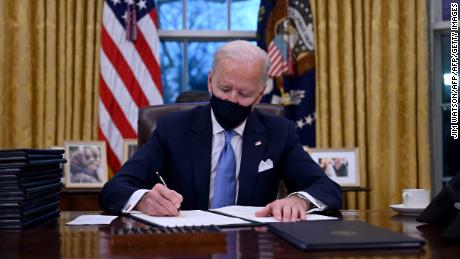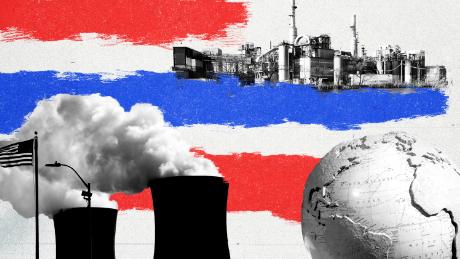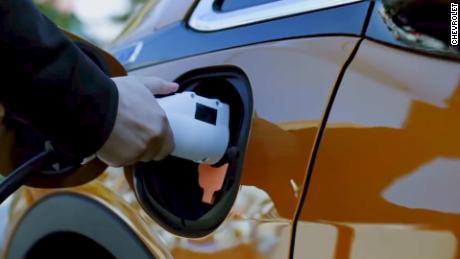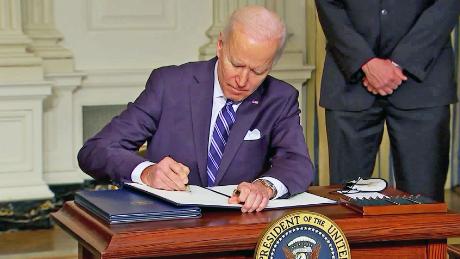Here's what Biden must do to get more electric cars on the road
(CNN)President Joe Biden's push to accelerate the nation's transition toward electric vehicles offers him a game-changing opportunity to jolt the climate change debate -- if he can quell simmering tension between two key elements of the Democratic coalition.
If
Biden can convince auto companies and autoworkers that they will
prosper in a historic transition that replaces the internal combustion
engine with zero-emission electric vehicles,
that could allow him to build support for aggressive actions on the
climate crisis across the industrial Midwestern states such as Michigan,
Wisconsin and Minnesota that remain key to the Democrats' political
fortunes.
Such a consensus -- which took a giant step forward when General Motors last week set a goal of transitioning
its entire line of cars and trucks by 2035 to vehicles that don't emit
any greenhouse gases -- would reconfigure the map of the climate debate.
Building support for a clean energy economy in the Midwest states
pivotal for Democrats would isolate opposition mostly to the Plains and
Mountain West states that produce the most fossil fuels -- which as a
group worry Democrats less because most of them already lean strongly
toward the GOP.
"As
people around the country and the areas that have been producing cars
understand that there's a lot of jobs to be created by producing
electric cars, it changes everything," says Fred Krupp, president of the
Environmental Defense Fund, who consulted with GM on its recent goal to
go emission-free by 2035.
The
challenge for Democrats is that organized labor, while agreeing that
the shift toward electric vehicles is inevitable, still worries that
their production requires much less labor than that of cars and trucks
powered by the conventional internal combustion engine -- and fret that
many of the key parts in EVs, particularly their batteries, are now
manufactured almost exclusively abroad.
Those
concerns leave labor uneasy about the pressure from environmentalists
for Biden to set pollution reduction regulations through the
Environmental Protection Agency that would effectively ban the sale of
all or most internal combustion engine vehicles by 2035 -- a step that
Biden steadfastly resisted during the Democratic primary campaign, when
rivals such as Vermont's Sen. Bernie Sanders proposed an even earlier
prohibition.
Electric
vehicles are "the direction we have to go but we need to make sure that
we are creating jobs in America, starting with battery production,"
Democratic Rep. Debbie Dingell of Michigan, who is close with organized
labor, told me. "We need to make those batteries here, source the
technology of that, and we have to look at how do we bring parts
production back from other countries."
Cars and trucks have always been a critical battlefield in the climate change debate because they are the largest single source of greenhouse gas emissions in the United States.
But electric vehicles have only recently taken center stage in the
discussion of how to cut transportation-related emissions. When
President Barack Obama, building on pioneering rules passed by
California, imposed sweeping requirements
in his first term on auto manufacturers to improve fuel economy (and
thus reduce the amount of greenhouse gases emitted per gallon of
gasoline), electric vehicles played only a tangential role in the plan;
the requirements focused mostly on squeezing out greater efficiency from
the traditional internal combustion engine.
President Donald Trump's administration moved to significantly dilute Obama's fuel economy regulations
and to revoke the separate authority California wields under the Clean
Air Act to set its own standards. But while Trump tried to turn back the
regulatory clock, the marketplace was hurtling forward: Electric
vehicles made enormous strides in technology and consumer acceptance
during his presidency. That's created the conditions for Biden to
achieve far greater emission reductions from transportation than even
Obama's plan envisioned.
Marketplace is shifting
"The
world is different today than it was then: People in our discussions
understand that the future is about electric vehicles," Gina McCarthy, Biden's top White House adviser on climate,
told me in an interview Monday. "The questions that we have been
talking about are how do we make sure that we do this in a way that the
labor community is engaged, that we advance the manufacture of these
vehicles in the US and that we establish standards that are reasonable,
but also achieve getting to zero [emissions] as quickly as we can, and
what does that date look like?"
Critically,
McCarthy, who ran the EPA during Obama's second term, adds, "the
conversation has been really not about improvements in the internal
combustion engine, which I'm sure we will end up talking about and
regulating, but it's also going to be clearly about how quickly we get
to zero [emissions]" from cars and light trucks.
Shifts
in the marketplace -- capped by GM's dramatic announcement last week
that it will move to a zero-emissions future -- are what's allowed the
Biden team to contemplate that visionary possibility.
The
transition extends far beyond GM: Kristin Dziczek, a vice president at
the Center for Automotive Research in Ann Arbor, Michigan, says that
since 2017, when Trump took office, roughly four-fifths of all automaker
investments in the US have been for manufacturing and research related
to electric vehicles.
"This
is where they are putting their money," she told me. "GM was loud and
made a very bold statement, but several other automakers are in the same
camp."
Today,
she says, automakers offer about 67 vehicles on the spectrum from
hybrid to plug-in hybrids to fully electric cars and light trucks; by
2024, that number is expected to soar past 200.
While
all vehicle sales dropped by about 14% amid the pandemic last year, she
says, sales for all forms of electric vehicles rose by about 5%. Tesla has become a powerful force
in the auto market, with its relatively more affordable Tesla 3 a
breakout hit. Dziczek projects that the number of purely electric
vehicles built in the US will more than double from just over 400,000 in
2020 to about 935,000 in 2024, with enough other companies joining the
procession that Tesla will produce only about one-third of that future
total, down from about 90% today.
Still,
while that growth is impressive from a marketplace perspective, it
doesn't approach the scale required to bend the curve on greenhouse
emissions. (Experts consider fully electric vehicles the key to climate
progress because they do not emit any greenhouse gases, unlike hybrids,
which still rely largely on internal combustion engines.) Full EVs still
make up only about 1.6% of new vehicle sales, according to the Center
for Automotive Research. Even with steady growth, the group projects
that under current policies, EVs will represent only about 1 in every 10
new cars sold by 2030.
Chester
France, who spent nearly 40 years at the EPA on air pollution issues
and now consults for the Environmental Defense Fund, says he has seen
more optimistic private forecasts from auto companies that anticipate
fully electric vehicles might reach 20% or 25% of the market by then.
"I personally think we are at the tipping point," he says. But, France adds, under any projection, "it's got to accelerate."
Autoworkers' worries
Throughout
the presidential campaign, Biden promised to turbocharge that
transition. His agenda included an array of incentives, such as funding
to build 500,000 electric charging stations over the next decade, tax
credits to encourage buyers to purchase EVs and the robust use of
federal purchasing power to jump-start the market. Only days after
taking office, he fulfilled one of those commitments when he announced
he intends to replace the entire federal fleet of nearly 650,000
vehicles with electric models; the charging stations and tax incentives
are expected to be included in the broader economic recovery package
he's slated to announce this month.
But
while Biden heartily embraced these carrots to encourage greater
adoption of electric vehicles, he pointedly kept his distance from any
sticks. During the primaries, when Sanders (and some others in the
field) proposed to ban the sale of internal combustion engine vehicles after 2030,
Biden refused to endorse the idea. When Biden's team negotiated a
"unity platform" with Sanders supporters, the former vice president
agreed to require utilities to generate all of their electricity from
zero-carbon sources by 2035 -- but still refused to set a similar
deadline for banning sales of new vehicles with internal combustion
engines.
Organized
labor strongly discouraged Biden from making such a commitment during
the campaign, one senior union official told me, asking not to be
identified while discussing internal conversations. That warning
reflects the strain of ambivalence in the union movement about a
potential large-scale shift to electric vehicles. Union leaders, the
official said, accept that such a shift is not only inevitable but also
indispensable.
"It's
real and you've got to do it -- there's a recognition that if you don't
do this in 10 or 15 years you are just out of business," the official
told me. "But," the official added, "there's a lot of trepidation around
job loss."
The
reason: Electric vehicles use vastly fewer parts than those powered by
the internal combustion engine -- which reduces employment up and down
the supply chain -- and require less time to assemble. In an extensive 2020 paper,
the United Auto Workers, citing the most frequently touted estimate,
projected that EVs might require 30% less labor than conventional
vehicles. Compounding the anxiety is that many of the parts for EVs are
now sourced from abroad. That imbalance is particularly pronounced for
the batteries that are their central component: About three-fourths of
those batteries are produced in China or elsewhere in Asia, and
projections are for that number to rise even further in the years ahead.
Environmentalists
argue that a complete accounting on the shift from the internal
combustion engine to electrified vehicles will show a net increase in
jobs.
"As
cars go electric, beyond the car itself, there is this need to
construct charging stations, [to generate] wind power, more solar
energy," to power the cars, says Krupp. "It would be fair to look at the
transition as a whole."
Electrifying
municipal transit and school buses and van fleets for package delivery
companies and utilities could also generate new manufacturing jobs that
offset any losses in the direct production of cars and light trucks for
consumers.
But
Krupp, like other environmentalists, acknowledges that a key to easing
labor's concerns about the shift to EVs is to develop policies that will
encourage the auto companies to produce more of the parts for them
domestically, particularly the batteries.
"You've
got to try to steer it," the senior labor official told me. "The fight
is about the job quality and making sure we have an effective industrial
policy that is going to help us land that production here."
"If we don't come up with policies to capture that ground," agrees France, "we will have a second-rate auto industry."
Biden
officials likewise believe the key to building broad support for any
potential transition away from the internal combustion engine is to
embed it into a larger agenda to create well-paying blue-collar jobs by
using federal procurement, tax incentives and trade policy as levers. I
asked McCarthy about the shot across the bow that Texas Republican Gov. Greg Abbott delivered last week, when he declared in a speech that he will fight any federal effort to reduce reliance on oil and gas.
"We
are not in a battle against the oil industry or certainly the state of
Texas," she replied. "The conversations we've been having with the car
companies make it very clear that the battle we are trying to fight is
to have the United States provide leadership in clean energy, because
that is what's going to grow and stabilize our economy. So our fight is
all about jobs; our job is all about manufacturing. That's our
battlefield."
Carrots and sticks
Given Biden's commitment during the "unity" process with Sanders,
sources inside and outside the administration consider it likely that
the EPA will pursue regulations that set the utility industry on a path
toward zero-emission electricity by 2035. If Biden combined that with
comparable requirements steering the automotive industry toward a
zero-emission future, that would constitute a powerful one-two
regulatory offensive on climate -- especially when joined with all the
other incentives, from tax breaks to federal procurement, that he's
advancing to accelerate a shift toward clean energy.
After
Trump's efforts to roll back Obama's rules requiring automakers to
improve fuel economy and reduce greenhouse gas emissions, the Biden team
is committed to establishing new national rules for cars and trucks.
"We certainly going to move to federal standards, and that's no question," McCarthy told me.
But
it's uncertain whether those rules will limit emissions of carbon
dioxide and other pollutants to the point that they would effectively
ban sales of new internal combustion vehicles at some future date -- the
notion Biden resisted during the campaign. The answer will likely
depend on whether the President can convince the key stakeholders,
particularly the UAW and other relevant unions, that they can prosper in
a fully electrified future.
Environmentalists are already pushing for such a ban:
Advocates such as Krupp want the administration to set rules that would
effectively prohibit sales of new vehicles with internal combustion
engines after 2035. GM's announcement last week, by demonstrating that
such a major manufacturer believes that cutoff is feasible, "is going to
make the Biden administration's path ... easier" to imposing such a
rule, Krupp argues. California Democratic Gov. Gavin Newsom last fall likewise announced
that the state will require all new vehicles to be emission-free by
2035. (China, whose massive market heavily influences the auto
companies' planning, has imposed a similar mandate as well.)
McCarthy
indicated the administration is not ready to commit to such a
requirement, but she also suggested they do not see it as outside the
parameters of the possible. While no decisions have been made, she says,
in the administration's initial conversations with the auto industry,
"Nobody is hanging on to the old; they are all looking at how they can
retool for the future."
Any
such rule would not require consumers to turn in their existing
vehicles powered by internal combustion engines, and with about 275
million on them on the road, and the average vehicle lasting about 15
years, plenty would still be motoring around America until the middle of
this century. But such a requirement would point toward a zero-emission
future for transportation and a dramatic long-term decline in the
country's consumption of gasoline and diesel. That, plus a parallel
requirement for utilities, would surely prompt scorched-earth resistance
from the fossil fuel industry, and the states where it exerts the most
economic and political influence.
As
I've noted before, those states now overwhelmingly send to Washington
Republican senators and House members opposed to any action on climate.
(In 2020, Trump won 20 of the 21 states that emit the most carbon dioxide per dollar of economic output, and Republicans hold 37 of their 42 Senate seats.)
That phalanx of opposition from the fossil-fuel-producing states -- what I've called the "brown blockade"--
makes it very difficult for Democrats to pass legislation mandating
reductions in greenhouse gases, at least so long as the Senate maintains
the filibuster. But Biden seems to be moving toward a clean energy
agenda that creates a division of responsibility: He may rely on
Congress only to pass the "carrots" encouraging the shift -- like
building more charging stations or offering tax credits -- while relying
on executive branch regulatory action for his "sticks" -- limiting
greenhouse gas emissions from utilities and vehicles.
That approach carries its own risks, particularly that a conservative Supreme Court may block his
regulatory actions. But there's no question that Biden and other
Democrats will feel more comfortable moving down this path if they
believe it's broadly acceptable in the Midwestern industrial
battlegrounds that remain central to their electoral map.
"This
is where Biden's message is so important -- that these are the jobs of
the future," says Gene Karpinski, president of the League of
Conservation Voters, a leading environmental group. "People have to
understand that and agree with that, but that's the powerful case to
make. The job growth in the Midwest should be directly tied to the
visionary standards that we need to meet [for clean vehicles] in the
next 15 years."
Which
means that in the climate debate, convincing the manufacturing states
that they can thrive in a clean-energy future may be Biden's job one.










No comments